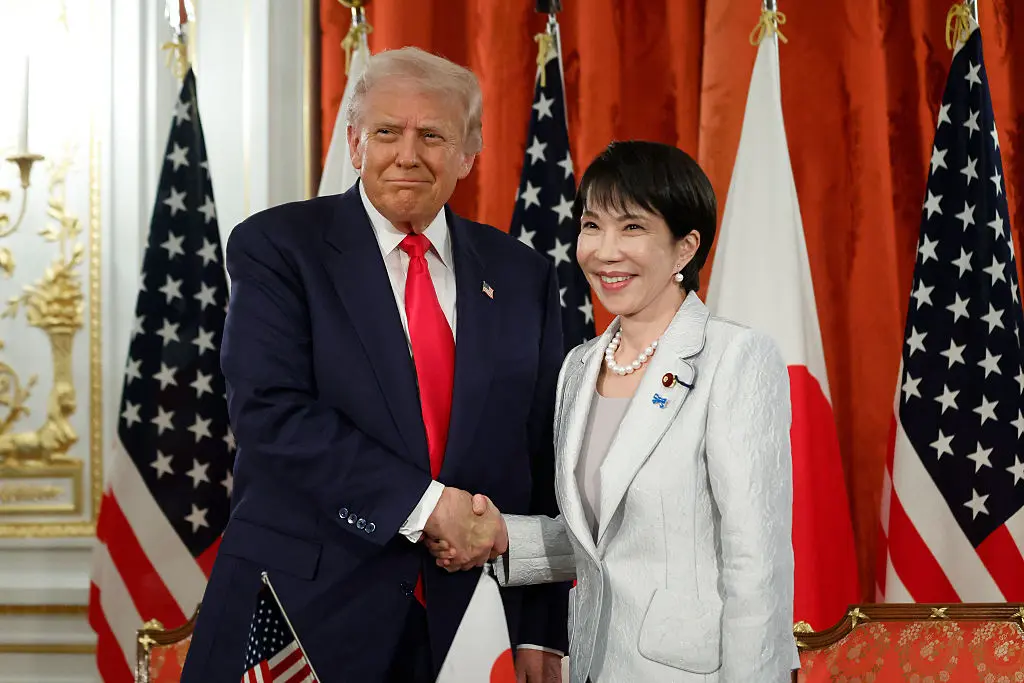President Donald Trump’s visit to Tokyo marked a defining moment in the evolving relationship between the United States and Japan, as he met with Japan’s newly appointed Prime Minister, Sanae Takaichi, the first woman to lead the nation. The two leaders celebrated the signing of a $550 billion trade and investment deal, commonly referred to as the Trump Japan $550 billion trade deal, that aims to boost U.S. manufacturing, secure critical mineral supply chains, and reinforce the long-standing strategic alliance between both countries.
A $550 Billion Pact for a “Golden Age” in U.S.-Japan Relations
The historic agreement between Trump and Takaichi has been described as the foundation of a “golden age” of cooperation between Washington and Tokyo. This Trump Japan $550 billion trade deal outlines a commitment from Japan to invest in the U.S. economy through industrial expansion, green technology development, and rare earth mining. This initiative aligns with ongoing efforts by both governments to reduce reliance on Chinese supply chains and bolster domestic industries. According to reports from Reuters, Japan will allocate a significant portion of the investment to American infrastructure projects and defense manufacturing facilities.
Trump emphasized that the alliance represents more than just a financial arrangement — it’s a reaffirmation of shared democratic values and mutual defense commitments. During a working lunch at Tokyo’s Akasaka Palace, Trump expressed confidence in Takaichi’s leadership, calling her “a strong and visionary leader,” while highlighting Japan’s symbolic gift of 250 cherry trees to commemorate the 250th anniversary of U.S. independence. The Trump Japan $550 billion economic agreement exemplifies this strengthened partnership.
Strengthening Strategic Cooperation in Defense and Technology
A major focus of Trump’s visit was reinforcing military and technological collaboration between the two nations, which is crucial for the Trump Japan $550 billion trade deal. The leaders signed an additional agreement centered on the joint development of advanced defense technologies, rare earth resources, and artificial intelligence infrastructure. The U.S. and Japan have pledged to coordinate with private-sector innovators such as Lockheed Martin y Toyota Motor Corporation to accelerate progress in aerospace, renewable energy, and autonomous vehicles.
Trump and Takaichi’s public appearances underscored a deepening alliance amid regional tensions, particularly regarding North Korea and China’s expanding influence in the Indo-Pacific. Trump also addressed U.S. troops aboard the USS George Washington, stationed near Tokyo, where he praised Japanese defense investments and highlighted Toyota’s $10 billion plan to expand manufacturing facilities in the United States. This highlights their commitment to maintaining peace and stability in the Pacific region while promoting open markets and secure trade routes. Such strategic goals are deeply intertwined with what is broadly called the Trump Japan’s ambitious $550 billion trade deal.
Economic Diplomacy and the Future of U.S.-Japan Trade
Beyond military cooperation, the trade component of Trump’s visit underscored a broader push for economic resilience. Takaichi’s administration has shown strong interest in diversifying Japan’s economic ties and participating in the modernization of American industry. The agreement’s inclusion of incentives for Japanese automakers to increase exports of U.S.-made vehicles signals a new era of reciprocity. Experts believe this could reshape the automobile trade landscape, which is heavily influenced by the Trump Japan $550 billion trade deal, traditionally dominated by imports from Japan.
Additionally, the U.S. Department of Commerce and Japan’s Ministry of Economy, Trade and Industry plan to establish a joint innovation council, supported by major corporations and universities from both nations. According to Nikkei Asia, this council will oversee the development of AI research hubs and facilitate cross-border investment in digital infrastructure.
The Tokyo summit concluded with symbolic gestures — including an exchange of gifts related to golf diplomacy and a shared declaration of friendship — but its implications extend far beyond ceremony. Trump’s efforts to secure Japan’s unprecedented $550 billion commitment, known widely as the Trump Japan $550 billion trade deal, have not only strengthened America’s economic position but have also cemented a renewed partnership that could shape the balance of power in the Indo-Pacific for decades to come.



